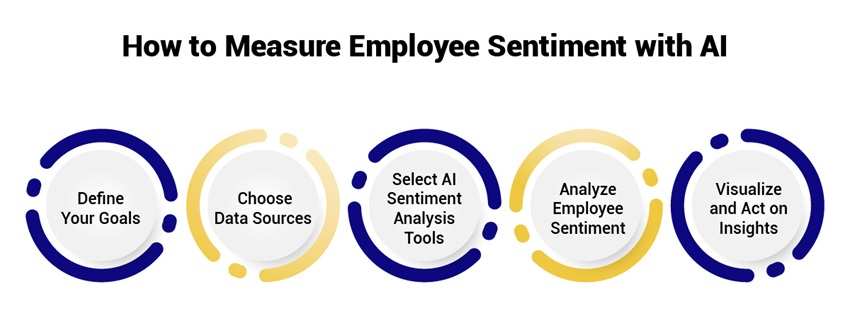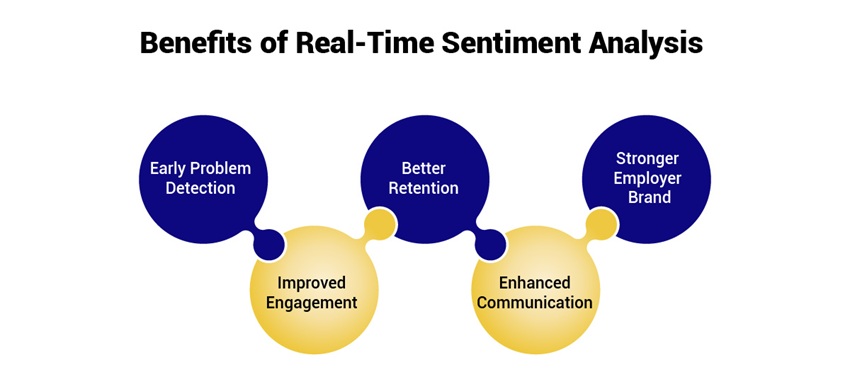
Employee engagement directly affects productivity, retention, and even a company's reputation. But how do you know what your employees really feel? This is where sentiment analysis and AI come in, offering a powerful way to measure employee sentiment in real time. By using AI-driven sentiment analysis, HR teams can uncover insights, address concerns quickly, and create a better work environment.
This article explores how this technology works, why it matters, and how HR can use it to improve engagement effectively.
Employee Sentiment refers to the feelings, attitudes, and opinions employees have about their jobs, workplace, and employer. It’s like a mood check for your team. Positive sentiment means employees feel happy, motivated, and proud to be part of the company. This leads to higher productivity and lower turnover rates.
Neutral sentiment shows employees aren’t thrilled or upset, they’re just okay, which can shift either way. Negative sentiment, on the other hand, signals dissatisfaction, low morale, and even increased absenteeism, which can hurt the whole organization if ignored.
Measuring employee sentiment is crucial because it gives HR leaders a clear picture of the workforce’s emotional health. According to Gallup, companies that improved their engagement strategies saw turnover drop by 21% to 51%. This shows that understanding and acting on employee sentiment can save money and build a stronger team. Plus, it helps identify issues early, enhance morale, improve retention, and align company culture with employee values. With AI-driven sentiment analysis, this process becomes faster and more accurate, letting HR make smart, data-driven decisions in real time.
Sentiment analysis is the process of analyzing emotions and opinions from text or speech. Traditionally, this meant manually reading surveys or feedback, which was slow and prone to mistakes.
Now, AI changes the game by using natural language processing (NLP) to automatically detect feelings like happiness, frustration, or neutrality in employee responses. Tools like Qualtrics or Explorance MLY can process large amounts of data, surveys, emails, or chat messages, and spot trends instantly.
AI-driven sentiment analysis works by training machine learning models to recognize patterns in language. For example, words like “great” or “excited” signal positive sentiment, while “stressed” or “unfair” point to negative feelings. The AI then tags these themes, organizes the data, and assigns sentiment scores to give HR a clear overview. This real-time capability means issues can be spotted and addressed before they escalate, making it a game-changer for employee engagement.
To get the most out of AI-driven sentiment analysis, HR needs a solid plan. Here’s a simple step-by-step guide to measure employee sentiment effectively:

Start by deciding what you want to learn. Are you checking overall job satisfaction, looking for specific pain points, or measuring the impact of a new policy? Clear goals guide the process and ensure the data is useful. For instance, if turnover is high, focus on why employees might be leaving.
Gather feedback from multiple places:
Pick tools that fit your needs. Platforms like SurveyMonkey, Typeform, or Qualtrics offer survey features, while advanced options like Thrive Sparrow use AI to analyze text and video. These tools save time and provide unbiased insights by detecting emotional tones automatically.
Use AI to dig into the data. The technology identifies patterns, such as repeated mentions of “workload” or “support,” and links them to factors like department or tenure. This helps HR see what’s driving positive or negative employee sentiment.
Turn data into easy-to-understand charts or graphs using tools like Microsoft PowerBI. Then, create action plans based on findings, addressing workload issues with flexible hours or boosting morale with recognition programs. Sharing results with employees shows you value their input, enhancing trust.
The right questions unlock valuable insights. Mix quantitative (rated) and qualitative (open-ended) questions to get a full picture. Here are some examples:
Keep questions clear and specific to avoid confusion. Regular surveys, post-onboarding, quarterly, or after projects, keep you updated without overwhelming employees.
Real-time AI-driven sentiment analysis offers unique advantages over traditional methods:

Gallup notes that managers influence 70% of engagement levels. Real-time analysis can pinpoint poor management practices, like micromanagement, allowing targeted training to improve employee engagement.
Once you have insights from sentiment analysis, HR can take action. Here are six areas to focus on:
Even with AI, challenges can arise. Here’s how to handle them:
Several tools support this process:
These tools, paired with AI, make sentiment analysis accessible and effective for HR teams.
The following real-world examples showcase how AI-powered sentiment analysis is transforming industries. From automotive to airlines, companies are leveraging this technology to improve experiences, and drive success.
Widewail’s 2023 Voice of the Customer Report looked at over 1.5 million Google reviews from more than 16,000 new-car dealerships to find trends in customer behavior and feelings. The data shows that dealerships with friendly, skilled staff and good communication get more positive reviews. To enhance these reviews, dealers should focus on training staff to be helpful and kind, especially in sales.
The analysis also found that clear communication can cut down on negative reviews. AI sentiment analysis helps them quickly review lots of feedback and use it to improve products and track their brand’s reputation.
Marriott International, a huge hotel chain with over 7,000 properties, uses AI to analyze customer reviews. They also rely on chatbots on their booking site. By spotting common themes and feelings in reviews, Marriott can quickly find areas to improve, like room cleanliness, staff friendliness, or amenities.
This real-time feedback lets individual hotels fix problems fast and improve guest stays. At the company level, Marriott compares performance across properties, learns from the best ones, and makes smart choices to build a stronger brand.
Amazon uses AI sentiment analysis to check millions of product reviews and understand customer satisfaction. By looking at how people feel about products, Amazon can see which ones customers love and which ones need work.
This helps them update product listings, improve descriptions, and guide product development. For example, if reviews often mention tough assembly, Amazon can team up with manufacturers to simplify instructions or offer assembly help.
McDonald’s uses AI to track customer sentiment across its 38,000+ locations by reviewing feedback and social media. This helps them spot issues fast, like a new menu item getting bad reviews or a location struggling.
With this information, McDonald’s can act quickly, tweaking recipes, training staff more, or fixing supply problems. Keeping an eye on sentiment helps them protect their brand and build customer loyalty.
Delta Air Lines uses AI sentiment analysis to look at customer feedback from reviews, surveys, and social media. By studying sentiment trends, they can find trouble spots in the customer experience, like long check-in lines, flight delays, or poor in-flight service.
These details help Delta focus on the biggest issues and use resources wisely. For instance, if baggage handling gets a lot of complaints, Delta can improve systems and train staff to make the experience better.
Sentiment analysis powered by AI is transforming how HR measures and increases employee engagement. By capturing real-time Employee Sentiment, HR can address issues promptly, improve morale, and reduce turnover. With the right tools, questions, and strategies, companies can create a supportive workplace where employees thrive. Start using AI-driven sentiment analysis today to unlock the full potential of your workforce and build a stronger, happier team.